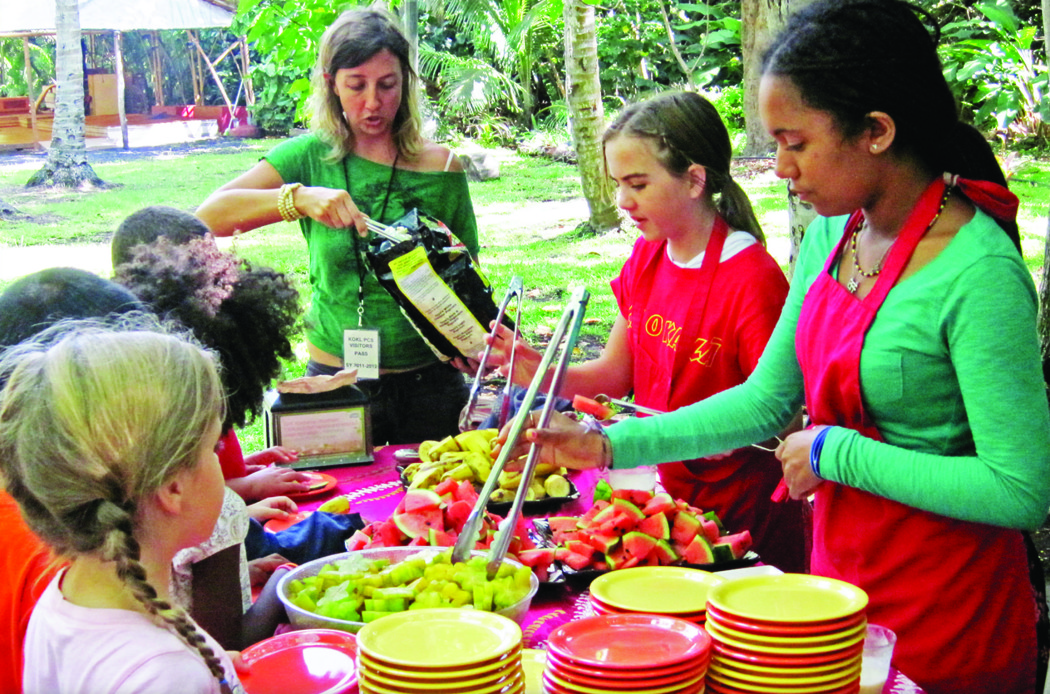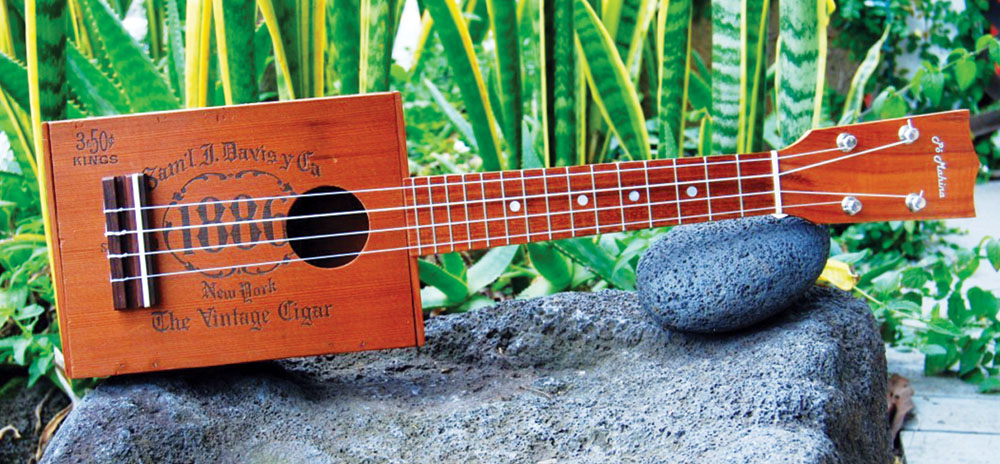
A Whole New Palate: Seed-to-Table Gives Kids a New Appreciation for Food
 By Prana Mandoe
By Prana Mandoe
A group of middle-school cooks is hanging out by the blender on a picnic table at Kua O Ka Lā Public Charter School (KOKL). The kids just whipped up coconut-liliko’i smoothies… oh!—and grilled beef and lime with yacon (a tuber that looks like a potato but tastes like an apple). They’ve prepared coconut-sweet-potato salad, cucumber salad and stir-fried kale… banana tamales with pineapple, ‘ohelo berries and fresh-squeezed coconut cream… and steaming cups of mamaki tea. The occasion? The planning committee for the Hawai’i Island Breadfruit Festival is having lunch with the staff of Kua O Ka Lā. The kids prepared this feast AND fed fresh fruit to the elementary school in just two hours.
“I work them hard,” says their teacher, Mariposa Blanco.
Her class, ‘Āina Life Culinary Arts, cooks only locally grown foods. This means coconut oil, kalo, breadfruit in season, wild pig and the photography teacher’s cow. There are greens, tomatoes, and peppers from the school garden, plus an array of veggies from Puna area farms. The chefs and diners adjust themselves to a whole new palate. And that’s the point.
Changing people’s palate means expanding or shifting the range of tastes a person enjoys. The current “local” palate prefers white rice, meat, eggs, gravy, and sugary drinks. Think Loco-Moco or SPAM musubi with an Arizona Green Tea, and you’ve got the picture. Unfortunately, a diet based on these kinds of foods is high in fat, salt and sugar. It’s a pathway to diabetes, hypertension and heart disease. Furthermore, it includes few locally-grown ingredients. Our society burns an expensive pollutant—oil—to ship food here. Changing our palate—‘Āina Life style—means learning to enjoy food made with fresh, whole ingredients grown or gathered on our island.
“I know it sounds gross, but it actually tastes good,” wrote one dedicated cooking student. She was referring to all the vegetables. And the class works with fruits and veggies galore!
Every Friday, the culinary arts students wash fruit, cut it up, and serve it to the younger grades for snacks. Next, they listen as Blanco—known as Aunty Mariposa to the kids—introduces the ingredients and dishes of the day. She shares plant genealogies: where the vegetables grew on island and where in the world they originally came from. For example, tomatoes were domesticated in Central and South America, while kalo migrated from Southeast Asia through the Pacific. Together, Aunty Mariposa and the students invent recipes: salsas, salads, soups, stews and surprising fruity desserts. They cook familiar dishes like beef stew (with ‘ulu!), comfort foods such as purple ‘uala shepherd’s pie and dishes they have never heard of, like Roma tomatoes with mozzarella cheese and basil.
The ‘Āina Life class supplies lunch to participating school staff at an affordable price. It’s a way of taking care of the school’s hard workers, according to KOKL Director Susie Osborne. The teachers, aides, and administrators sit down to their gourmet lunch in a setting that can’t be beat: springwater glistens and steams through a grove of milo trees. Waves crash just out of sight on the lava coast. Kua O Ka Lā and its parent nonprofit, Ho’oulu Lahui, are located at Pu’ala’a in lower Puna; lunch is served in an ancient fishing village within a native coastal forest. Both the food and the environment
are delicious.
It thrills the students when the staff eats and compliments their cooking. Likewise, it thrills the staff when Aunty Mariposa says, “Today all the students ate everything.” A taste for “real food” that’s not overloaded with sugar or processed beyond recognition is an asset for health in today’s world! Rhea Davis, an 8th grade student, weighs in: “I think they should have a cooking class in every school.”
This past September, Davis and her classmates entered the 1st Annual Breadfruit Festival cooking competition in Kealakekua, Kona. (KOKL is hosting a sister festival in Puna on March 3rd, 2012.) The ‘Āina Life Culinary Arts class placed first for Main Dish/Entree and Healthiest Choice. Their entry was ‘Ulu Tamales with Coleslaw and Salsa. In desserts, their ‘Ulu Pops took second. What a thrill! But winning is the icing, not the inspiration for the “cake.” In the words of Hope Butay, a 7th grade student, “The thought of [the food] being fresh, pretty and locally-grown made me think we should do more.”
This engagement marks success. Aunty Mariposa dreamed up ‘Āina Life for the health of local youth, and KOKL director Osborne made it happen through a grant from the federal Administration for Native Americans (ANA). Together, they created a “seed-to-table” program called ‘Ike ‘Āina. Let’s break that down: ‘Ike, in Hawaiian, is “to see, know, feel, experience, recognize and understand.” ‘Āina is the word for land and earth; it comes from ‘ai, which means to eat. So ‘Ike ‘Āina is to know the land, and KOKL’s Agriculture and Culinary Arts program focuses on knowing food from the earth. The overall goal is to develop garden and kitchen programs to support a healthy, sustainable lifestyle for Native Hawaiian students and families in Puna by: developing food-producing relationships with the earth; processing, cooking, and eating healthy, organic, locally-grown foods; and building a certified commercial kitchen.
The ANA grant includes money to outfit the inside of the certified kitchen: stainless steel counters, appliances, and so on. Osborne is currently raising funds to construct the building in which it will be housed, and the Office of Hawaiian Affairs has already committed money. Let’s hope the full sum is reached soon, because the students are ready. They line up for a spot in Culinary Arts, which takes only eight students per semester. For every class, they set up and break down the kitchen in a canopy tent. But if you imagine packing and unpacking a kitchen is challenging, you haven’t heard about Agriculture.
The Kua O Ka Lā garden started with rock. In the first year, students cleared out logs, spread cinder, laid down drywall (for calcium) and shoveled dirt over it. Under the direction of Agriculture teacher “Mama” Chioke Mims, they dug holes in the lava. They built Puna-style pu’u: raised rock rings for holding soil and moisture. They sweated and grumbled in a big way. One student described the garden site as a “rocky hell” that first year. The next season saw the first Roma tomatoes. Students looked at caterpillars under magnifying glasses. They shaped raised beds from imported Hāmākua plantation dirt. They sweated and grumbled some more. Now, in the third year, students are skimming irrigation water off plastic and tinkering with home-made catchment tanks. They are building soil by mulching paper, lauhala and Mims’ locally-resourced compost blend. They’re practicing multiple planting styles: pu’u, rock, raised-bed and
vertical-greenhouse agriculture.
Are they still grumbling? Of course. The sun is hot. School time is smack-dab in the middle of the worst gardening hours possible. And many of the youth are not used to this work. They don’t walk, mulch, shovel, pull weeds, stack rocks or carry water as a matter of course. Neither are most trained to be quiet. They are not used to observing the land, plants, bugs, and weather, or to looking, listening, and following through with care. Mims and fellow teacher Prana Mandoe (yours truly) work to awaken and develop these indigenous, human skills within the students.
Slowly, it’s happening.
Now, on a typical Friday, Mims harvests greens and vegetables for Culinary Arts. Then the students arrive and check on their peppers, cucumbers, kalo, kale, chard, mamaki and more. Many find a work groove watering or planting seedlings. The students discuss varieties of frogs and whether a bug is a whitefly or aphid. They wash and taste string bean and tomato samples right in the garden. They recently nursed a patch of brittle, yellow peppers back from near-death. When the kids babied those plants, the leaves greened and darkened. Life returned. The plants set Grade-A bell peppers.
“Did you know that organic red bell peppers sell for $4.99 a pound in the stores?” Mama Chioke asks the students.
It’s a rhetorical question. The KOKL program isn’t ready for sales (except to staff), but it’s a thought for entrepreneurial students to consider. In fact, it could become an applied math program. First, though, the kids have to know their products.
“I ate my first green bell pepper,” 7th grader Malea Morris announces.
“First in your life?” I ask.
“Yep,” she answers. “I thought it would be really spicy, but I tried it and now I’m addicted.”
Morris’s classmate, Karley Rose, has a similar take on the vegetables. She and her cousin raised a crop of cucumbers this fall. They dug holes in the lava, planted seedlings, watered, and mulched with leaves and paper. The girls watched with pleasure as the vines quickly climbed the garden fence. They also found cucumber worms and examined them on the classroom projector. (These pests eat cucumbers from the inside out, leaving only a crunchy empty shell.) When the cukes were finally ready, they supplied staff lunches and contributed quarts of cucumber salad for the school’s Makahiki feast. Rose also took cucumbers home, where she prepared them kimchee style. “It was good,” she reported.
That’s beginning to be the feeling at Agriculture class. Students from the first tough years are now in 9th and 10th grade. This year at Makahiki, a few of these boys dropped by as the middle schoolers practiced pounding poi.
“Is that kalo from our garden?” they asked. It was. This was the crop the 9th grade planted and the 10th grade prepared the ground for. The boys sampled the pa’i ‘ai (thick, unmixed poi) straight from the poi board. They took a turn pounding, and they nodded approval. All their work would grace the table for the school’s feast. The whole community would eat a traditional
Hawaiian staple grown by the students. That was a proud moment, a turning point.
Another pivotal moment came recently, when students excitedly discussed what to grow for the school’s first “Iron Chef of Agriculture” competition as they left the garden site.
“I want to put liliko’i and lemon in a bowl and soak yacon in it, then sprinkle grated coconut on top,” 7th grader Keali’i Luis told his friend.
That’s ‘Ike ‘Āina in action. Tradition and innovation. For most of us, it’s a whole new palate.
Look for Kua O Ka Lā staff and students’ recipes, quotes, and gardening notes in our upcoming cookbook, ‘Ike ‘Āina, available at the Pu’ala’a ‘Ulu Festival and through Kua O Ka Lā Public Charter School. 808.965.5098; www.kuaokala.org
Contact writer Prana Mandoe at prana@hawaiiantel.net.


